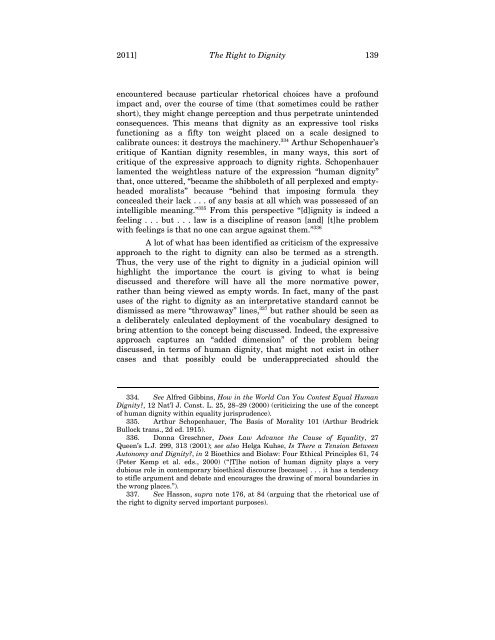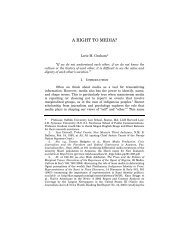The Right to Dignity Rex D. Glensy - Columbia Law School
The Right to Dignity Rex D. Glensy - Columbia Law School
The Right to Dignity Rex D. Glensy - Columbia Law School
You also want an ePaper? Increase the reach of your titles
YUMPU automatically turns print PDFs into web optimized ePapers that Google loves.
2011] <strong>The</strong> <strong>Right</strong> <strong>to</strong> <strong>Dignity</strong> 139<br />
encountered because particular rhe<strong>to</strong>rical choices have a profound<br />
impact and, over the course of time (that sometimes could be rather<br />
short), they might change perception and thus perpetrate unintended<br />
consequences. This means that dignity as an expressive <strong>to</strong>ol risks<br />
functioning as a fifty <strong>to</strong>n weight placed on a scale designed <strong>to</strong><br />
calibrate ounces: it destroys the machinery. 334 Arthur Schopenhauer’s<br />
critique of Kantian dignity resembles, in many ways, this sort of<br />
critique of the expressive approach <strong>to</strong> dignity rights. Schopenhauer<br />
lamented the weightless nature of the expression “human dignity”<br />
that, once uttered, “became the shibboleth of all perplexed and empty<br />
headed moralists” because “behind that imposing formula they<br />
concealed their lack . . . of any basis at all which was possessed of an<br />
intelligible meaning.” 335 From this perspective “[d]ignity is indeed a<br />
feeling . . . but . . . law is a discipline of reason [and] [t]he problem<br />
with feelings is that no one can argue against them.” 336<br />
A lot of what has been identified as criticism of the expressive<br />
approach <strong>to</strong> the right <strong>to</strong> dignity can also be termed as a strength.<br />
Thus, the very use of the right <strong>to</strong> dignity in a judicial opinion will<br />
highlight the importance the court is giving <strong>to</strong> what is being<br />
discussed and therefore will have all the more normative power,<br />
rather than being viewed as empty words. In fact, many of the past<br />
uses of the right <strong>to</strong> dignity as an interpretative standard cannot be<br />
dismissed as mere “throwaway” lines, 337 but rather should be seen as<br />
a deliberately calculated deployment of the vocabulary designed <strong>to</strong><br />
bring attention <strong>to</strong> the concept being discussed. Indeed, the expressive<br />
approach captures an “added dimension” of the problem being<br />
discussed, in terms of human dignity, that might not exist in other<br />
cases and that possibly could be underappreciated should the<br />
334. See Alfred Gibbins, How in the World Can You Contest Equal Human<br />
<strong>Dignity</strong>?, 12 Nat’l J. Const. L. 25, 28–29 (2000) (criticizing the use of the concept<br />
of human dignity within equality jurisprudence).<br />
335. Arthur Schopenhauer, <strong>The</strong> Basis of Morality 101 (Arthur Brodrick<br />
Bullock trans., 2d ed. 1915).<br />
336. Donna Greschner, Does <strong>Law</strong> Advance the Cause of Equality, 27<br />
Queen’s L.J. 299, 313 (2001); see also Helga Kuhse, Is <strong>The</strong>re a Tension Between<br />
Au<strong>to</strong>nomy and <strong>Dignity</strong>?, in 2 Bioethics and Biolaw: Four Ethical Principles 61, 74<br />
(Peter Kemp et al. eds., 2000) (“[T]he notion of human dignity plays a very<br />
dubious role in contemporary bioethical discourse [because] . . . it has a tendency<br />
<strong>to</strong> stifle argument and debate and encourages the drawing of moral boundaries in<br />
the wrong places.”).<br />
337. See Hasson, supra note 176, at 84 (arguing that the rhe<strong>to</strong>rical use of<br />
the right <strong>to</strong> dignity served important purposes).















